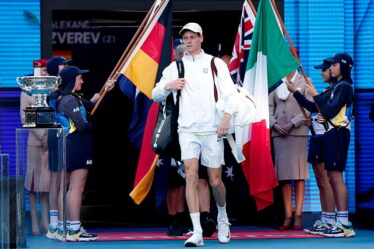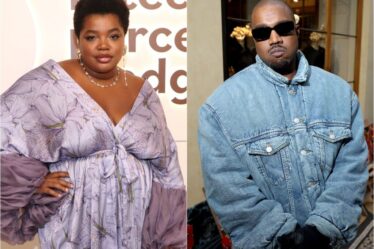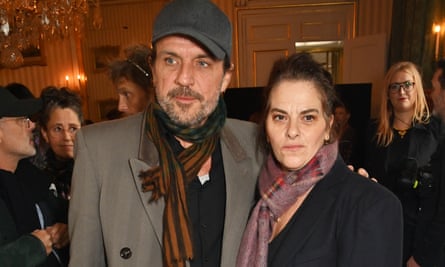
Less than three months after the death of Vivienne Westwood, her widower and collaborator, Andreas Kronthaler, is still in the thick of overwhelming grief.
“It comes in waves,” he said, speaking backstage before the label’s show in Paris on Saturday. “This work has been kind of helpful, yes. But sometimes you pick something up, and then it hits you. But this is my personal tribute to her.”
Kronthaler had been designing Westwood’s collections for more than five years when the designer died just after Christmas last year. Towards the end she pitched in on the collection, the first since her death, but only when she was “physically able to”, he said. Then, she handed it all over.
Westwood met Kronthaler in 1989 at the Vienna School of Applied Arts, where she was a visiting professor. Their relationship was kept secret for some time. At Westwood’s memorial in February, Kronthaler spoke of furtive glances and stolen kisses down alleyways after class. He created a collection of gowns inspired by the Renaissance, Westwood invited him to develop them in London and, by 1993, the pair were married.
Though not unaware of her conflicting position as a designer whose brand model relied on sales as much as conscience, she was also the first designer to encourage her customers to buy less of it.
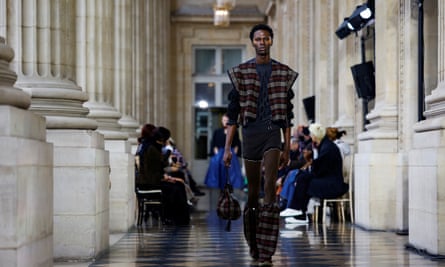
To that end, Kronthaler ensured the entire collection was made from deadstock fabric, 18th-century hangings and old bedding, often patchworked together. This was partly about tapping into Westwood’s lifelong crusade against waste, the idea of “buy less, choose well”, but also served as an act of catharsis for Kronthaler. “I collect and hang on to things but this time I just [needed] to get rid of it.” And so, half a metre of silk became a sleeve here, or a pair of knickers there.
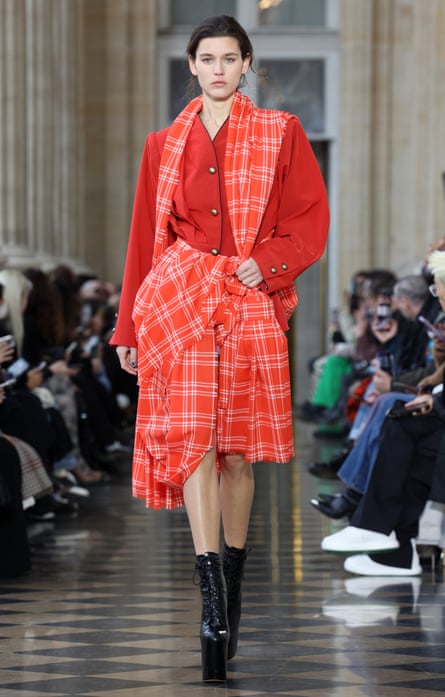
Even to the most nascent Westwood fan, the collection was clearly archive-inspired, starting with the most obvious hallmarks: those towering platforms buckled up the shins, which Kronthaler insisted on making even higher, forgetting the moment Naomi Campbell made catwalk history in 1993 when she toppled in a pair of 12-inch heels. Not one platform-wearing model fell on Saturday.
Elsewhere, he gave classic further Westwoodisms a Kronthaler spin. The mini-crinoline skirts became midi-length, ruched stockings gathered deliberately under tweed knickers, boned corsets were wrapped in black tulle and some models wore spiked tin dog collars. Her famous buckled suede pirate boots, first seen in 1981 and beloved by Kate Moss throughout the 00s, were dusted off for one last turn. It was a show of dualities, of old meets new, of unisex styling – and of country and town. “Vivienne was drawn to nature, and cared about it, as we know, but she was also a city girl”, said Kronthaler. Even the music leapt from orchestral to AC/DC and back again.
Subtler references appeared in the makeup. Some models wore thin strips of Westwood’s trademark red eyeliner. Others sported stripes as worn by Adam Ant, one of Westwood’s early collaborators.
It wouldn’t be a Westwood show without some controversy. This time, it was a reworking of the “masturbation” skirt, gathered with a drawstring waist for easy removal. Ever the pragmatist, Kronthaler recalled how even that was designed so you could iron and machine wash it. “She was extremely practical like that,” he said.
Bursting on to the cultural landscape during the late 60s, in direct contradiction to the swinging fashions of London, Westwood used clothing as a way to reject social, gender and political norms. Her clothes defined the punk era, and her T-shirts were as much about political statements as they were sales. There were no slogans on Saturday, but there were plenty of bottoms, nipples and boys in dresses. The show closed with her granddaughter, Cora Corré, wearing a micro-length “wedding gown”.
Kronthaler dedicated the show to Tintwistle after the Derbyshire village where she grew up, learned to sew and is buried. “Out of this, I became involved in her again,” he said.

